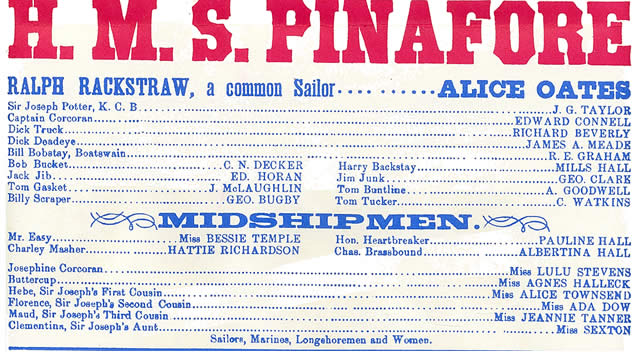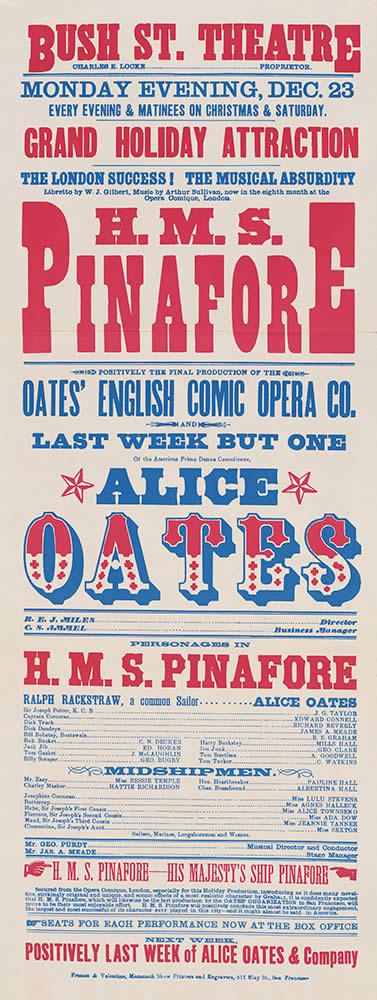 |
 |
||||||
Alice Oates' Comedy Opera Company Production
The Second American Production of H.M.S. Pinafore
On December 23rd, 1878, the Alice Oates’ English Comic Opera Company presented the second American production of Gilbert & Sullivan’s H.M.S. Pinafore in San Francisco. Boasting that Pinafore had been, “Secured from the Opera Comique, London, especially for this Holiday Production,” (Fig. 1) the Oates’ production was more than just a little unusual. It’s not quite clear just what the audience in fact experienced.
The “personages” listed in the cast are the first clue that this may not have a been a true production of Pinafore (Fig. 2). In addition to Capt. Corcoran, Ralph Rackstraw, Josephine, and other canonical characters, we also find Bob Bucket, Jack Jib, and Mr. Easy. The named “sisters and cousins and aunts” may be attributed to wanting to give names to each of Sir Joseph’s relatives, hence “Florence, Sir Joseph’s Second Cousin,” “Maud, Sir Joseph’s Third Cousin,” and so on. But what are we to make of “Charley Masher” and “Hon. Heartbreaker”?
Adding to the confusion, several non-Pinafore songs were interpolated, including “The Death of Nelson,” “Good-by, Sweetheart, Good-by,” and “All on the Bay of Biscay, O.” (One reviewer reported “The Death of Nelson” as “The Death of Melrose.” It is not at all clear that this was simply a typo in the review. The same review suggests that Sir Joseph’s Aunt, Clementina, sang Buttercup’s reveal. Perhaps the reviewer simply slept through the second act.) The fact that “Miss Lulu Stevens did very well with the small part of Josephine” [emphasis added] is also somewhat odd.
Nevertheless, the production was well received. Noting “the introduction of a number of songs not properly belonging to the opera” one reviewer praised the production as “a light and amusing trifle.” Other reviews noted “a great deal of light and attractive music.” One Sacramento reporter commented that Pinafore was a deserving follow-up to Sullivan’s Trial by Jury, and that it was “a burlesque not only of events and actors but of music, for in it every sort of composition – opera, madrigal, ballad, chant, and oratorio – is whimsically treated.”
From San Francisco, Miss Oates took her production east, to America’s Midwest. Though references suggest that the Oates company performed Pinafore in Kansas City, the first record we have is of a performance in St. Louis. The notice was less than enthusiastic:
The orchestra is composed of good individual players, but they have had no opportunity to study the music sufficiently to play it at all well together, and the ensemble therefore has been lamentable. The chorus is even worse. Mrs. Oates herself is certainly not the vocalist who won some distinction some years ago, and has only given us one or two numbers at all worthy of her old reputation. The male voices have but little claim to consideration…
We have no knowledge of the orchestrations used by the Oates company or other American productions. Reviews of Carte’s legitimate New York production of Pinafore in December, 1879, suggest that American orchestrations were substantially inferior to Sullivan’s. It is almost certain that local musicians were recruited when the Oates company arrived in town.
Throughout its tour of the American Midwest, the Oates English Comic Opera Company continued to receive less-than-wonderful reviews. The "Chicago Daily Tribune" wrote of the February performance,
Mrs. Oates was the Ralph Rackstraw, and did pretty well vocally, considering that the part belongs to a tenor. The librettist intended the character to be at least a semi-serious one; but the natural vivacity of Mrs. O. would not be restrained, and the sentimental topman was, if anything, a little livelier than the rest of the crew. … the Dick Deadeye of last night couldn’t sing at all; and Sir Joseph Porter… was a failure both in voice and manner. … The conductor of the troupe must think that we are still in the Middle Ages, or he would never have stricken out the pretty song of Capt. Corcoran, “Why is everything either at sixes or at sevens?” and the succeeding very effective duet between the Captain and Little Buttercup, and substituted therefor such relics of antiquity as “England, Home, and Beauty,” “Good-Bye, Sweetheart, Good-bye,” “Larboard Watch, Ahoy,” and “The Bay of Biscay, O,” – especially as these venerable ditties could not be made to assume the slightest relevance to the subject matter of the play.
A subsequent review in the "Tribune" noted that when the Oates troupe took Pinafore, “… by applying the methods of opera-bouffe to it, as well as innumerable interpolations, succeeded in utterly ruining it.” In March, 1879, the Oates company brought Pinafore to Cincinnati, Ohio. A review in the "Cincinnati Daily Gazette" notes that the Oates production followed well-received amateur and professional productions, and suffered by comparison, and that
The Mrs. Oates company labors under a serious difficulty, because Mrs. Oates takes the part of Ralph Rackstraw and in doing so has to fill the part of a tenor in concerted pieces. The musical effect may be imagined.
Following this less-than-successful engagement, the Oates English Comic Opera Company apparently abandoned Pinafore and continued their Midwestern tour with other operas in their repertoire, including Lecocq’s Le Petit Duc.
A final note: It was common for American productions to feature women – usually sopranos – as Ralph Rackstraw. The first American production at the Boston Museum featured Rose Temple in that role. This was perhaps in response to a scarcity of decent tenors, with one wag remarking, “most Ralphs in Pinafore ought to be called Singbad the Sailor.”


